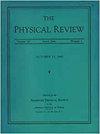Transform-limited dissipative Kerr solitons with an ultraflat spectrum in a Fabry-Pérot microresonator with a spectral filter
引用次数: 0
Abstract
The interplay between the dispersion and spectral filtering effect in Kerr-ring resonators allows the formation of dispersion-less Kerr solitons, an alternative class of Kerr solitons featuring with ultrabroad spectrum and zero chirp. In contrast to a ring resonator, the nonlinear interactions between the counterpropagating light waves in a F-P resonator introduce an additional phase shift, which modifies the system-effective detuning, hence impacting the soliton existence range and its formation dynamics. In this article, we investigate numerically the formation of dissipative Kerr solitons (DKSs) in a 10-mm-long Fabry-P\'erot (FP) microresonator with a super-Gaussian spectral filter in the normal dispersion regime. Simulation results found that the spectral loss provided by the filter plays a significant role in the formation of DKS. Without the filter, the FP microresonator yields platicons featuring a flat-top pulse with oscillating tails on both sides. For a super-Gaussian spectral filter with an order of $n\ensuremath{\rightarrow}\ensuremath{\infty}$, the resonator approaches the transform-limited DKS regime with ultraflat spectrum. An intermediate state of chaotic states of multipulses was observed in the transition from the platicon to the transform-limited DKSs when using the detuning scan technology, the dependence of the appearance of the chaotic state on the spectral filtering effect. Finally, the energy-width scaling behavior and the enhancement of the performances of the transform-limited DKS are studied. Simulation results deepen our understanding of nonlinear dynamics of transform-limited DKS combs and point out a way for achieving a high-energy DKS comb with ultraflat spectrum in Kerr resonators.带光谱滤波器的法布里-帕氏微谐振器中具有超平坦谱的变换限制耗散克尔孤子
克尔环谐振器中色散和光谱滤波效应之间的相互作用允许形成无色散克尔孤子,这是克尔孤子的另一类,具有超远光谱和零啁啾。与环形谐振器相比,F-P谐振器中反向传播光波之间的非线性相互作用引入了额外的相移,这改变了系统有效失谐,从而影响了孤子的存在范围及其形成动力学。在本文中,我们用数值方法研究了在正常色散状态下,具有超高斯谱滤波器的10毫米长的fabry - p (FP)微谐振器中耗散克尔孤子(DKSs)的形成。仿真结果表明,滤波器提供的频谱损耗对DKS的形成起着重要的作用。在没有滤波器的情况下,FP微谐振器产生的脉冲具有平顶脉冲,两侧有振荡尾。对于阶为$n\ensuremath{\rightarrow}\ensuremath{\infty}$的超高斯谱滤波器,谐振腔接近具有超平坦谱的变换受限DKS区。利用失谐扫描技术,观察到多脉冲在从平台到变换受限dks的过渡过程中存在中间混沌状态,混沌状态的出现与谱滤波效果的关系。最后,研究了变换受限DKS的能量宽度缩放行为和性能的增强。仿真结果加深了我们对变换受限DKS梳的非线性动力学的理解,并为在Kerr谐振器中实现具有超平坦光谱的高能DKS梳指明了一条途径。
本文章由计算机程序翻译,如有差异,请以英文原文为准。
求助全文
约1分钟内获得全文
求助全文

 求助内容:
求助内容: 应助结果提醒方式:
应助结果提醒方式:


